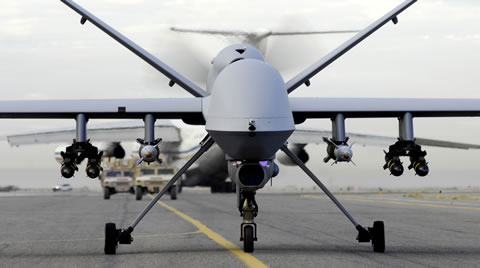Since September 2007 Sky Warrior and MQ-9 Reaper weaponized UAVs began flying combat sorties in support of coalition forces operations in Afghanistan. Currently, the USAF 42nd UAV attack squadron and US Army 82nd Combat Aviation Brigade are flying the armed UAVs while RAF No 39 squadron fly unarmed ISR missions in support of coalition forces in theater.
The first of three British Royal Air Force (RAF) Reapers arrived in Afghanistan in early October and has since made several flights in theater. These unmanned aircraft were acquired by Britain from General Atomics to meet an urgent operational requirement for set by the Royal Air Force (RAF) for all-weather, persistent Intelligence, Surveillance, Target Acquisition and Reconnaissance (ISTAR) capability 24 hours a day over a wide geographical spread.

 Unlike the USAF Reapers, used as ‘hunter killer’ platforms, loaded with guided bombs and Hellfire missiles, the RAF Reaper UAVs are currently unarmed but the RAF is planning to fly armed missions as soon as by 2007 year’s end.
Unlike the USAF Reapers, used as ‘hunter killer’ platforms, loaded with guided bombs and Hellfire missiles, the RAF Reaper UAVs are currently unarmed but the RAF is planning to fly armed missions as soon as by 2007 year’s end.
The primary mission of USAF Reapers is as a persistent hunter-killer against emerging targets in support of joint force commander objectives. The MQ-9’s secondary mission is to act as an intelligence, surveillance and reconnaissance asset, employing sensors to provide real-time data to commanders and intelligence specialists at all levels. The aircraft was engaged in combat for the first time on October 27, 2007, targeting enemy combatants in Deh Rawod with a hellfire missile. The strike was reported as successful.
Lt. Gen. Gary North, commander of U.S. Central Command Air Forces, who said the Reaper was a perfect complement to the Air Force’s existing manned airborne platforms. He added that he expects the Reaper to bring a significant impact to military operations throughout the U.S. Central Command area of responsibility. “The enemy knows we track them and they know that if and when they commit acts against their people and government, we will take action against them.”
 The USAF Reaper are operational in Afghanistan since September 2007 averaging about one sortie per day. As practiced with Predator As, Reapers are operated by the 42nd Attack Squadron based at Creech AFB, Nev., with pilots and weapon systems operators seated in Nevada, controlling the aircraft remotely over Afghanistan. Meanwhile, beginning September 2007, the US Army has also deployed the first Sky Warrior to Afghanistan. The aircraft designated Sky Warrior-A are assigned to the 82nd Combat Aviation Brigade ‘Task Force Charger’, responsible for operating the UAVs on operations throughout the theater.
The USAF Reaper are operational in Afghanistan since September 2007 averaging about one sortie per day. As practiced with Predator As, Reapers are operated by the 42nd Attack Squadron based at Creech AFB, Nev., with pilots and weapon systems operators seated in Nevada, controlling the aircraft remotely over Afghanistan. Meanwhile, beginning September 2007, the US Army has also deployed the first Sky Warrior to Afghanistan. The aircraft designated Sky Warrior-A are assigned to the 82nd Combat Aviation Brigade ‘Task Force Charger’, responsible for operating the UAVs on operations throughout the theater.
Unlike the Air Force’s remote operation concept, the Army operates its Sky Warriors from facilities in theater, claiming better responsiveness and coordination with ground operations. However, the US Army and Air Force are in disagreement about who will be controlling these UAVs in theater.
 The RAF’s participation in the joint US/UK Combined Predator Task Force gave them a unique insight into the USAF (US Air Force) Predator A operations, which allowed a seamless transition to the RAF’s use of Reaper, the UK variant of Predator B.
The RAF’s participation in the joint US/UK Combined Predator Task Force gave them a unique insight into the USAF (US Air Force) Predator A operations, which allowed a seamless transition to the RAF’s use of Reaper, the UK variant of Predator B.
Training for pilots and sensor operators is provided by the USAF, building on the experience of No 1115 Flight operating Predator A. This squadron was formed in 2004 and was embedded with the USAF since its establishment operating Predator A. No 1115 will continue to operate Predator As, while administratively becoming part of No 39 Squadron – predominantly an RAF unit, the squadron also have Army and Navy personnel working in a number of functional areas.
The aircraft is flown on operational and training missions, providing capability assessment and doctrine development. The RAF expects steady build up to a full UK capability as more experience is gathered.
















